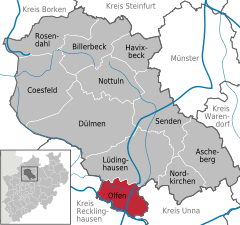Olfen
From Wikipedia, the free encyclopedia
For the anti-inflammatory drug, see Diclofenac.
| Olfen | ||
|---|---|---|
| ||
 Olfen | ||
Location of Olfen within Coesfeld district 
 | ||
| Coordinates: 51°43′N 7°23′E / 51.717°N 7.383°ECoordinates: 51°43′N 7°23′E / 51.717°N 7.383°E | ||
| Country | Germany | |
| State | North Rhine-Westphalia | |
| Admin. region | Münster | |
| District | Coesfeld | |
| Government | ||
| • Mayor | Josef Himmelmann (CDU) | |
| Area | ||
| • Total | 52.43 km2 (20.24 sq mi) | |
| Elevation | 45 - 80 m (−217 ft) | |
| Population (2012-12-31)[1] | ||
| • Total | 12,134 | |
| • Density | 230/km2 (600/sq mi) | |
| Time zone | CET/CEST (UTC+1/+2) | |
| Postal codes | 59399 | |
| Dialling codes |
02595 02592 (part of Vinnums) | |
| Vehicle registration | COE | |
| Website | www.olfen.de | |
Olfen is a municipality in the district of Coesfeld, in North Rhine-Westphalia, Germany. It is sometimes called the "Gate to the Ruhr Area". It is also considered the "horse-friendliest town in North Rhine-Westphalia." Interesting sights include a castle and historic sawmill.
History
Bishop Wolfhelm, who originated from the Ulfloa Oberhof, gave the small town its name. It was in the year 889. Wolfhelm was the fourth Bishop of "Mimingardeford", today called Münster.
The fire disaster of 1857, in which 142 houses were destroyed, has gone down as the "Great Fire of Olfen" in Olfen's history books.
[See the German version for more details.]
| |||||||
References
- ↑ "Amtliche Bevölkerungszahlen". Landesbetrieb Information und Technik NRW (in German). 31 July 2013.
This article is issued from Wikipedia. The text is available under the Creative Commons Attribution/Share Alike; additional terms may apply for the media files.
